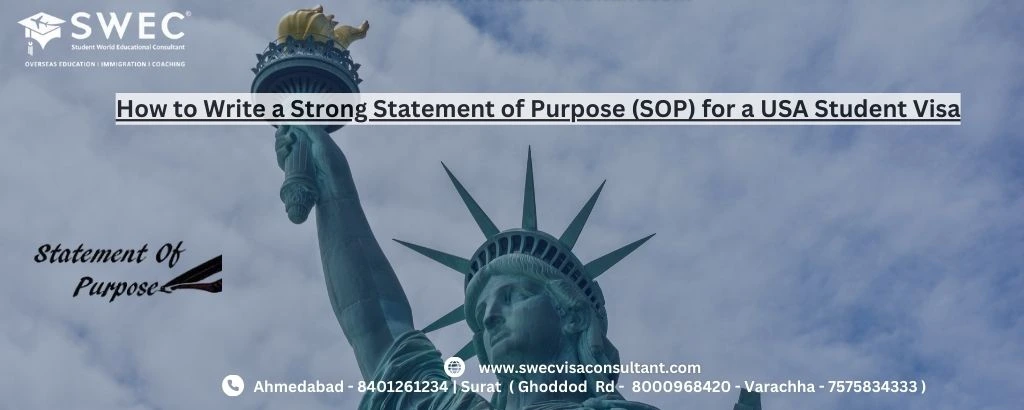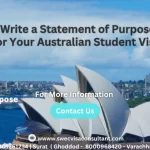A Statement of Purpose (SOP) is a crucial document required by universities and visa authorities, especially in the USA. It is a personal essay that allows applicants to articulate their academic interests, career objectives, and reasons for pursuing education abroad. In the context of a USA student visa application, the SOP serves as a narrative that showcases an applicant’s unique qualities, aspirations, and motivations for choosing a particular program and institution.
The SOP plays a pivotal role in the visa application process for several reasons. Firstly, it gives visa officers insights into the applicant’s background, academic achievements, and plans. Secondly, a well-structured SOP can significantly influence admission decisions made by universities. It reflects the applicant’s commitment and seriousness toward their education, which is crucial for securing both admission and visa approval. A compelling SOP can enhance the chances of receiving a student visa, as it demonstrates the applicant’s intent to study genuinely and responsibly.
The primary objective of this blog is to provide a comprehensive guide on writing an effective SOP that aligns with the applicant’s academic and career goals. By understanding the nuances of an SOP, Indian students can craft a narrative that stands out, increasing their chances of admission to their desired programs and obtaining a USA student visa.
Table of Contents
The Purpose of an SOP
Why Do Institutions Require an SOP?
Universities and colleges in the USA require an SOP to assess candidates holistically. While academic records, test scores, and recommendations are essential, they only provide a partial view of the applicant. The SOP gives institutions a glimpse into the applicant’s personality, motivations, and readiness for the challenges of studying abroad. It helps admission committees evaluate whether the candidate is a good fit for the program and the institution’s culture.
Understanding the perspective of universities and visa officers is vital. They seek students who can contribute positively to the academic environment and who have clear goals. An SOP that conveys passion for the chosen field, demonstrates past achievements and outlines future ambitions can effectively illustrate the applicant’s alignment with the institution’s values.
How an SOP Reflects Your Journey
An SOP is not just a list of achievements; it is a narrative that reflects the applicant’s journey. It allows candidates to share their stories, challenges, and triumphs, painting a picture of who they are beyond their academic credentials. By highlighting personal experiences, applicants can convey their resilience, determination, and adaptability—qualities that are highly valued in any educational setting.
For example, an applicant might discuss how overcoming academic challenges ignited their passion for a specific field of study. By sharing such experiences, the SOP becomes a window into the applicant’s motivations, background, and future aspirations, making it a powerful tool in the application process.
Connecting Academic Goals with Visa Requirements
A well-crafted SOP serves a dual purpose: meeting both academic and visa application needs. For visa officers, the SOP helps establish that the applicant has a genuine intent to study and is aware of the responsibilities that come with being an international student. It should outline how the chosen program aligns with the applicant’s academic goals and how studying in the USA will facilitate their future career.
Incorporating specific details about the program, faculty, and unique opportunities offered by the institution can enhance the SOP. Demonstrating a clear connection between the applicant’s educational objectives and the requirements of the visa process can create a compelling narrative that addresses the concerns of both admission committees and visa authorities.
Breaking Down the Structure of an SOP
Crafting a well-structured Statement of Purpose (SOP) is essential for effectively conveying your academic journey, motivations, and aspirations. Here’s a breakdown of the key components that should be included in an SOP:
Introduction
The introduction is your first opportunity to grab the reader’s attention and set the tone for your SOP. It should be compelling and relevant, offering a glimpse into your personality and academic interests. Consider starting with an engaging anecdote or a thought-provoking question that relates to your field of study. This will not only make your SOP memorable but also provide context for the rest of your narrative.
Academic Background
In this section, detail your educational history, including your undergraduate degree, coursework, and any relevant projects. Highlight your academic achievements, such as awards or honours, and explain how these experiences have shaped your academic interests. Make sure to connect your past educational experiences to your future goals, demonstrating a clear trajectory of growth and development.
Professional Experience
If applicable, discuss your internships, jobs, or research experiences that contribute to your academic goals. Explain how these experiences have prepared you for further studies and enriched your understanding of your chosen field. For example, if you completed an internship in a relevant industry, elaborate on the skills you acquired and how they align with your intended program of study.
Motivation for Choosing the USA
Articulate your reasons for preferring the USA over other countries for your education. This could include factors such as the quality of education, the diversity of programs, or the opportunity to learn from leading experts in your field. Highlighting specific aspects of the American education system that appeal to you will demonstrate your genuine interest and commitment.
Selecting the Right Institution and Program
In this section, explain the criteria you used to choose your particular university and program. Discuss the unique features of the institution that attracted you, such as faculty expertise, research opportunities, or campus culture. This not only shows that you have done your research but also emphasizes your fit for the program.
Career Aspirations
Define your short-term and long-term career goals, and explain how the chosen program will help you achieve them. Be specific about what you hope to accomplish after completing your studies and how the skills and knowledge gained will contribute to your professional growth. This demonstrates to both admission committees and visa officers that you have a clear vision for your future.
Conclusion
Summarize your SOP with a strong closing statement that reinforces your intent to pursue your studies in the USA. Restate your enthusiasm for the program and express gratitude for the opportunity to apply. A well-crafted conclusion leaves a lasting impression and underscores your commitment to your academic and career aspirations.
Crafting an Authentic and Persuasive SOP
An SOP is a personal reflection of your journey and aspirations. To make it authentic and persuasive, consider the following strategies:
Personalization
Tailoring your SOP to reflect your unique experiences and goals is essential. Avoid generic statements and instead focus on specific incidents that shaped your academic and career choices. Personalization helps you stand out and demonstrates your genuine interest in the program.
Storytelling
Using a narrative approach makes your SOP engaging and memorable. Share your story in a way that resonates with the reader, illustrating your passion for your field of study and your motivations for pursuing education in the USA. Incorporate anecdotes that highlight your strengths and demonstrate how your experiences have prepared you for the challenges ahead.
Highlighting Strengths and Addressing Weaknesses
While it’s essential to emphasize your strengths, it’s also important to provide context for any academic or professional gaps. If you faced challenges in your academic journey, briefly mention them and explain how you overcame those obstacles. This not only shows resilience but also reflects your ability to learn and grow from experiences.
Common Mistakes to Avoid in Your SOP
Writing a compelling Statement of Purpose (SOP) requires careful consideration of its content and structure. Here are some common mistakes applicants often make and how to avoid them:
Generic and Clichéd Statements
Using generic phrases or clichés can weaken your SOP and make it less memorable. Phrases like “I have always wanted to study in the USA” or “I am passionate about learning” are overused and fail to convey your unique journey. To avoid this pitfall, focus on specific experiences or insights that have shaped your academic interests. Instead of relying on clichés, tell a personal story that illustrates your passion and commitment to your field.
Lack of Focus
Maintaining a clear narrative throughout your SOP is crucial. A common mistake is to stray off-topic or include irrelevant information that distracts from your main message. To stay focused, outline your key points before you start writing and ensure each paragraph ties back to your academic and career goals. This will help create a cohesive narrative that keeps the reader engaged.
Ignoring the Prompt or Guidelines
Each institution may have specific requirements or prompts for the SOP. Failing to adhere to these guidelines can lead to your application being disregarded. Always read the prompt carefully and ensure that your SOP addresses the specific questions or themes outlined. If a university asks for your reasons for choosing a particular program, make sure to explicitly discuss this in your SOP.
Exaggeration and Overconfidence
While it’s important to showcase your strengths, exaggerating your achievements or expressing unrealistic goals can come across as insincere. Be honest about your experiences and future aspirations. Instead of claiming to be the “best” in your field, focus on what you have learned and how you plan to grow through the program. Authenticity is key to building trust with the admissions committee and visa officers.
Practical Tips for Writing a Strong SOP
To enhance the quality of your SOP, consider the following practical tips that will help you create a compelling and polished document:
Researching the Program and Institution
Before writing your SOP, take the time to thoroughly research the program and institution you are applying to. Understand their values, mission, and unique offerings. This knowledge will allow you to align your SOP with the institution’s goals and demonstrate that you are a good fit. Highlight specific faculty members, research opportunities, or programs that appeal to you, showing that you are genuinely interested in what they offer.
Drafting and Redrafting
Writing an SOP is a process that often requires multiple drafts and revisions. After completing your first draft, set it aside for a few days before revisiting it. This break will give you a fresh perspective and help you identify areas for improvement. Aim for clarity, coherence, and a compelling narrative in your revisions. Each draft should bring you closer to a polished final product.
Seeking Feedback
Getting input from mentors, peers, or professional advisors can be invaluable in refining your SOP. Share your draft with individuals who understand your field of study and can provide constructive feedback. They may offer insights on how to improve your narrative, clarify your goals, or strengthen your overall message. Be open to criticism and use it to enhance your SOP.
Editing and Proofreading
Once you have finalized your content, it’s essential to edit and proofread your SOP thoroughly. Look for grammatical errors, awkward phrasing, and inconsistencies. A well-written and error-free SOP reflects your attention to detail and professionalism. Consider reading your SOP aloud to catch any issues with flow or clarity. Additionally, you may use online tools to help identify errors and improve your writing.
Tailoring Your SOP for Different Scenarios
When writing a Statement of Purpose (SOP), it’s crucial to tailor your content according to the specific program and level of study you are applying for. Here’s how to approach SOPs for different academic scenarios:
SOP for Undergraduate Programs
For students applying directly from high school, the SOP should emphasize enthusiasm for learning and exploration. Key focus areas include:
- Academic Interests: Discuss subjects that excite you and how they align with your chosen field of study.
- Extracurricular Activities: Highlight participation in clubs, sports, or volunteer work that demonstrates your skills and interests.
- Personal Growth: Reflect on any challenges you have faced and how they have shaped your character and aspirations.
SOP for Graduate Programs
Graduate applicants should concentrate on their academic journey and professional experiences. Important elements to consider include:
- Research Interests: Clearly outline your areas of interest and how they relate to the program.
- Professional Experience: Mention internships or jobs that have prepared you for advanced study and highlight relevant skills gained.
- Specific Academic Goals: Discuss what you hope to achieve during your graduate studies and how the program aligns with these goals.
SOP for Ph.D. Applicants
Ph.D. candidates should focus heavily on their research potential and academic accomplishments. Key points to include are:
- Research Achievements: Highlight any previous research projects or publications that showcase your capability.
- Academic Background: Detail your academic qualifications and relevant coursework.
- Future Contributions: Explain how you intend to contribute to the field through your research and what you hope to explore during your PhD journey.
SOP for Business Programs
When applying for business programs, your SOP should reflect leadership qualities and future career aspirations. Focus on:
- Leadership Skills: Provide examples of leadership roles you have held and the skills you developed.
- Entrepreneurial Mindset: Discuss any entrepreneurial experiences or projects you have initiated.
- Career Plans: Articulate your short-term and long-term career goals and how the program will help you achieve them.
Role of Language and Tone in an SOP
The language and tone you use in your SOP are crucial for conveying your message effectively. Here are some considerations:
Formal vs. Conversational Tone
Finding the right balance between professionalism and a personal voice is essential. While your SOP should maintain a formal tone, it should also reflect your personality. Use clear and concise language while incorporating personal anecdotes that make your narrative engaging.
Clear and Concise Language
Avoiding jargon and overly complex sentences is vital. Use straightforward language to communicate your ideas effectively. An engaging SOP is easy to read and allows the admissions committee to focus on your message rather than deciphering complicated wording.
Cultural Sensitivity
Be mindful of cultural references and expressions that may resonate with an international audience. While it’s important to express your background, ensure that your language and examples are relatable to a diverse readership. This consideration can enhance your appeal to a global admissions committee.
Leveraging Professional Help for Your SOP
Consider seeking professional assistance to enhance the quality of your SOP. Here’s when and how professional guidance can be beneficial:
When to Consider Professional Assistance
Professional help may be warranted if:
- You Lack Confidence: If you’re unsure about your writing skills or how to present your experiences.
- Limited Time: When deadlines are tight, and you need to ensure your SOP meets high standards.
- Desire for Objectivity: Professional writers can provide an unbiased perspective on your narrative.
Benefits of Professional SOP Writing Services
Experts in SOP writing can assist in various ways:
- Structuring Your SOP: They can help organize your content logically, ensuring a smooth flow of ideas.
- Editing and Polishing: Professional writers can refine your language and eliminate grammatical errors.
- Tailoring Content: They can ensure your SOP aligns with the specific requirements of the program you’re applying to.
Success Stories
Many students have successfully secured admissions by leveraging professional support. For instance, students who sought guidance in articulating their unique experiences and aspirations often received higher praise from admissions committees, leading to successful placements in their desired programs.
Conclusion
Writing a compelling Statement of Purpose involves understanding its significance, tailoring it for different scenarios, and paying attention to language and tone. Avoiding common pitfalls and seeking professional assistance can greatly enhance the quality of your SOP.
Take a thoughtful and well-researched approach to writing your SOP. Reflect on your experiences and articulate your academic and career goals clearly and authentically.
For personalized SOP writing assistance, consult with SWEC’s professional visa and immigration experts. We can help you craft an effective SOP that aligns with your aspirations and enhances your visa application process.
Frequently Asked Questions on SOP for US Student Visa
Q1. How to write a statement of purpose for a US university?
Ans1. To write a Statement of Purpose (SOP) for a US university, start by researching the program and institution. Structure your SOP with a clear introduction, academic background, professional experience, motivation for choosing the USA, selected institution and program, career aspirations, and a strong conclusion. Ensure to personalize your SOP, highlight relevant experiences, and connect your goals with what the program offers.
Q2. How many words should an SOP be for the USA?
Ans2. An SOP for a US university typically ranges between 500 to 1,000 words. However, it’s crucial to follow the specific guidelines provided by the institution, as some may have their word limits.
Q3. How to write a good statement of purpose for a Canada student visa?
Ans3. A good SOP for a Canada student visa should clearly outline your academic background, reasons for choosing Canada as a study destination, your chosen program and institution, future career goals, and how studying in Canada aligns with these aspirations. It should also address any gaps in your education or experience and emphasize your commitment to returning to your home country after your studies.
Q4. How to start a statement of purpose for a student visa?
Ans4. Start your SOP with a strong introduction that captures your motivation for pursuing higher education abroad. You might mention a defining moment in your academic journey or your long-term career goals to engage the reader.
Q5. How to write an SOP for a USA student visa?
Ans5. Writing an SOP for a USA student visa involves detailing your academic and professional background, reasons for choosing the USA, the specific program and university, career goals, and how this education will help you achieve those goals. Be honest, clear, and reflective of your motivations.
Q6. What is the first paragraph of the SOP?
Ans6. The first paragraph of the SOP should introduce who you are and your purpose for writing. It should include your academic background and your main motivations for pursuing the program, creating a hook that encourages the reader to continue.
Q7. Is 1500 words a lot for an SOP?
Ans7. Yes, 1500 words are generally considered too long for an SOP. Most institutions prefer concise statements, typically ranging from 500 to 1000 words. Be sure to check the specific word limit set by the institution you are applying to.
Q8. What is the format of a Statement of Purpose?
Ans8. The format of an SOP usually includes an introduction, body paragraphs detailing academic background, professional experiences, motivation for the chosen program and institution, career aspirations, and a conclusion. Use clear headings if allowed, and ensure proper grammar and formatting throughout.
Q9. Is 700 words enough for SOP?
Ans9. Yes, 700 words are generally sufficient for an SOP, as long as you effectively cover your motivations, experiences, and goals within that word count. Ensure that every sentence adds value to your narrative.
Q10. What is SOP after visa refusal?
Ans10. After a visa refusal, a Statement of Purpose (SOP) should address the concerns raised by the visa officer in the previous application. It should provide clarity on your motivations for studying abroad, your academic plans, and how you intend to comply with visa requirements.
Q11. What is the conclusion of the visa SOP?
Ans11. The conclusion of a visa SOP should summarize your key points and reiterate your commitment to your academic and career goals. It should also express your intention to adhere to the visa regulations and return to your home country after completing your studies.
Q12. How to write an introduction in SOP?
Ans12. An introduction in an SOP should provide a brief overview of who you are, your academic interests, and the primary motivation for pursuing your chosen program. It should be engaging and set a positive tone for the rest of the document.
Q13. How to convince a US visa officer for a student visa?
Ans13. To convince a US visa officer for a student visa, present a well-structured SOP that clearly explains your reasons for studying in the USA, your academic and career plans, and your ties to your home country, ensuring the officer understands your intentions are genuine.
Q14. How to write a perfect Statement of Purpose?
Ans14. A perfect Statement of Purpose should be personalized, concise, and well-structured. It should articulate your academic background, professional experiences, motivation for choosing the specific program and institution, and clearly defined career goals, all while maintaining clarity and coherence.
Q15. How can I introduce myself in the SOP for a student visa?
Ans15. Introduce yourself in the SOP by stating your name, current educational background, and the field of study you are pursuing. You can also include a brief personal anecdote that highlights your passion for the chosen field.
Q16. What are the 5 parts of SOP?
Ans16. The five parts of an SOP typically include:
- Introduction
- Academic background
- Professional experience
- Motivation for choosing the program and institution
- Career goals and conclusion
Q17. What is the best format for SOP?
Ans17. The best format for an SOP includes a clear structure with an introduction, and body paragraphs discussing academic and professional experiences, motivations, and aspirations, followed by a strong conclusion. Use clear paragraphs, and avoid long blocks of text.
Q18. Is SOP written in the first person?
Ans18. Yes, an SOP is typically written in the first person. This allows you to convey your personal experiences, motivations, and goals authentically.
Q19. Do visa officers read your SOP?
Ans19. Yes, visa officers do read your SOP. It helps them understand your motivations, goals, and intentions, which are crucial for deciding on your visa application.
Q20. Can I copy the SOP for the USA?
Ans20. No, copying an SOP is not advisable. Your SOP should reflect your unique experiences and aspirations. Plagiarism can lead to serious consequences, including visa refusal.
Q21. How much bank statement is required for a USA student visa?
Ans21. The amount required in a bank statement for a USA student visa varies by institution and program. Generally, you should show proof of funds to cover tuition and living expenses for at least one year, which can range from $20,000 to $60,000 or more, depending on the location and cost of living.
Q22. How to write a perfect SOP for a visa?
Ans22. To write a perfect SOP for a visa, clearly articulate your academic and professional background, motivations for studying abroad, specific program choices, and how this aligns with your future goals. Ensure it is personalized, concise, and addresses any potential concerns of the visa officer.
Q23. How to write a good Statement of Purpose for a visa application?
Ans23. A good Statement of Purpose for a visa application should outline your academic interests, reasons for choosing the specific country and institution, and future career goals. Make sure to emphasize your intentions to return to your home country after completing your studies.
Q24. How do I write a personal statement for a student visa?
Ans24. To write a personal statement for a student visa, describe your educational background, professional experiences, motivations for studying abroad, and how the program will help you achieve your goals. Be honest and reflect your personality.
Q25. Can I highlight words in SOP?
Ans25. It is generally advisable not to highlight words in an SOP. Use a standard font and formatting for clarity and professionalism. Highlighting may distract from the content itself.
Q26. What not to say in a Statement of Purpose?
Ans26. Avoid using clichés, making negative comments about previous experiences, expressing uncertainty about your goals, or including irrelevant personal information. Focus on your academic and professional journey instead.
Q27. How many pages is a SOP?
Ans27. A typical SOP is usually about 1 to 2 pages long, depending on the word count. Most institutions recommend a length of 500 to 1,000 words, which usually fits within this page range.
Q28. What makes a bad SOP?
Ans28. A bad SOP is generic, lacks focus, contains grammatical errors, is overly lengthy, or fails to connect the applicant’s experiences to their goals. It often reflects a lack of effort or understanding of the program.
Q29. Can SOP be 4 pages?
Ans29. While there is no strict rule against a 4-page SOP, it is generally considered too lengthy. Most institutions prefer concise statements of around 1 to 2 pages, so aim to communicate your points effectively within that limit.
Q30. How to justify backlogs in SOP?
Ans30. To justify backlogs in your SOP, be honest about the reasons for them and demonstrate how you have grown from those experiences. Highlight any subsequent achievements and how you have improved academically since then.
Q31. How should I start my SOP?
Ans31. Start your SOP with an engaging introduction that captures your motivations and background. You might begin with a personal story, a defining moment, or your passion for your field of study.
Q32. Can we start SOP with a quote?
Ans32. Starting your SOP with a quote can be effective if it is relevant to your story and resonates with your motivations. However, ensure that the quote does not overshadow your narrative and is followed by your insights.






